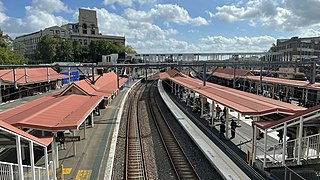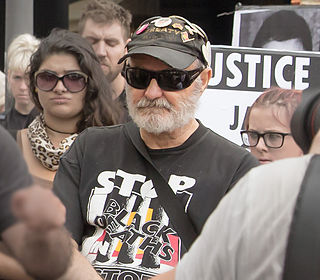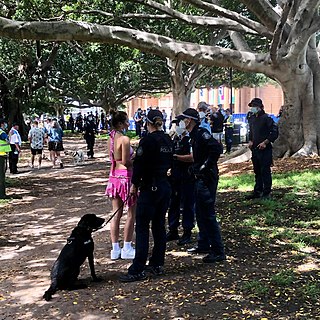
Redfern is an inner southern suburb of Sydney located 3 kilometres south of the Sydney central business district and is part of the local government area of the City of Sydney. Strawberry Hills is a locality on the border with Surry Hills. The area experienced the process of gentrification and is subject to extensive redevelopment plans by the state government, to increase the population and reduce the concentration of poverty in the suburb and neighbouring Waterloo.

The Waterloo Creek massacre refers to a series of violent clashes between mounted police, civilian vigilantes and Indigenous Gamilaraay peoples, which occurred southwest of Moree, New South Wales, Australia, during December 1837 and January 1838. The Waterloo Creek Massacre site is listed on the New South Wales Heritage Register as a place of significance in frontier violence leading to the murder of Gamilaraay people. The events have been subject to much dispute, due to wildly conflicting accounts by various participants and in subsequent reports and historical analyses, about the nature and number of fatalities and the lawfulness of the actions. Interpretation of the events at Waterloo Creek was raised again during the controversial "history wars" which began in the 1990s in Australia.

The Sydney Hilton Hotel bombing occurred on 13 February 1978, when a bomb exploded outside the Hilton Hotel in George Street, Sydney, Australia. At the time the hotel was hosting the first Commonwealth Heads of Government Regional Meeting (CHOGRM), a regional offshoot of the biennial meetings of the heads of government from across the Commonwealth of Nations.

Redfern railway station is a heritage-listed former railway bridge and now railway station located on the Main Suburban railway line in the Inner City Sydney suburb of Redfern in the City of Sydney local government area of New South Wales, Australia. It was designed by John Whitton and built by Department of Railways. It is also known as Redfern Railway Station group and Tenterfield railway. The property was added to the New South Wales State Heritage Register on 2 April 1999.

The Long Bay Correctional Complex, commonly called Long Bay, is a correctional facility comprising a heritage-listed maximum and minimum security prison for males and females and a hospital to treat prisoners, psychiatric cases and remandees, located in Malabar, Sydney, New South Wales, Australia. The complex is located approximately 14 kilometres (8.7 mi) south of the Sydney CBD and is contained within a 32-hectare (79-acre) site. The facility is operated by Corrective Services New South Wales, a department administered by the Government of New South Wales.

The Block is a colloquial but universally applied name given to a residential block of social housing in the suburb of Redfern, Sydney, bound by Eveleigh, Caroline, Louis and Vine Streets. Beginning in 1973, houses on this block were purchased over a period of 30 years by the Aboriginal Housing Company (AHC) for use as a project in Aboriginal-managed housing.
The 2005 Macquarie Fields riots were a series of disturbances in south-west Sydney in February 2005 which were referred to as a riot by both the Parliament of New South Wales and the media.

The 2005 Cronulla riots were a race riot in Sydney, New South Wales, Australia. It began in the beachside suburb of Cronulla on 11 December, and spread over to additional suburbs the next few nights.

Aboriginal deaths in custody is a political and social issue in Australia. It rose in prominence in the early 1980s, with Aboriginal activists campaigning following the death of 16-year-old John Peter Pat in 1983. Subsequent deaths in custody, considered suspicious by families of the deceased, culminated in the 1987 Royal Commission into Aboriginal Deaths in Custody (RCIADIC).

The Coroner's Court of New South Wales is the court in the Australian state of New South Wales where legal proceedings, in the form of an inquest or inquiry, are held and presided over by the State Coroner of New South Wales, a Deputy State Coroner of New South Wales, or another coroner of the state of New South Wales.
The 2004 Palm Island death in custody incident relates to the death of an Aboriginal resident of Palm Island, Cameron Doomadgee on Friday, 19 November 2004 in a police cell. The death of Mulrunji led to civic disturbances on the island and a legal, political and media sensation that continued for fourteen years.

The Sydney Ghost Train fire at Luna Park Sydney in Milsons Point, New South Wales, Australia, killed seven people, six children and one adult, on 9 June 1979. Inadequate fire-fighting measures and low staffing caused the fire to completely destroy the amusement park's ghost train. The ride is believed to have been first constructed in 1931 and transported between Milsons Point and Glenelg, South Australia, during 1934 and 1935.
Michael Capel, 43, a man with schizophrenia, died on 10 October 2008, from multiple gunshot wounds during a confrontation with police at Belmont, near Newcastle, New South Wales. The shooting followed reports that Capel had assaulted his mother and a local worker. Apparently Capel had come off his medication and become violent. A coronial inquest into Capel's death heard that he had "opened the door to police while holding a large knife and began walking towards officers". Following the death, a coroner has recommended special training for frontline police dealing with the mentally ill.

Operations Support Group (OSG) police are specialist police within the New South Wales Police Force. They are trained in public order (riot) response; weaponless control ; violent prisoner cell extractions; high-value asset protection; navigation and terrain search; bomb searching; and chemical, biological, radiological and nuclear (CBRN) response.
Roberto Laudisio Curti, known as Beto Laudisio, was a 21-year-old man from São Paulo, Brazil. He died on 18 March 2012 after being pursued, tackled, tasered, sprayed with OC spray, and physically compressed under the weight of multiple police officers of the New South Wales Police Force in Sydney, Australia.
The Aboriginal Legal Service (NSW/ACT) (ALS), known also as Aboriginal Legal Service, is a community-run organisation in New South Wales and the Australian Capital Territory, founded in 1970 to provide legal services to Aboriginal Australians and Torres Strait Islanders and based in the inner-Sydney suburb of Redfern. It now has branches across NSW and ACT, with its head office in Castlereagh Street, Sydney and a branch office in Regent Street, Redfern.

Ray Jackson was an Australian Aboriginal activist and Wiradjuri elder. He was President of the Indigenous Social Justice Association (ISJA), and a prominent campaigner for the rights of Indigenous Australians.
Elizabeth Lillian Fullerton is an Australian lawyer, specialising in criminal law, who has been a judge of the Supreme Court of New South Wales since February 2007.
David Joseph Dungay Jr was a 26-year-old Aboriginal Australian man who died in New South Wales Corrective Services custody at the Long Bay Correctional Centre on 29 December 2015. His death in custody prompted a coronial inquest which found "systemic deficiencies in training" of corrective services personnel.

The New South Wales Police Force strip search scandal refers to an ongoing policing scandal surrounding the routine and arbitrary use of strip searches by members of the New South Wales Police Force.












